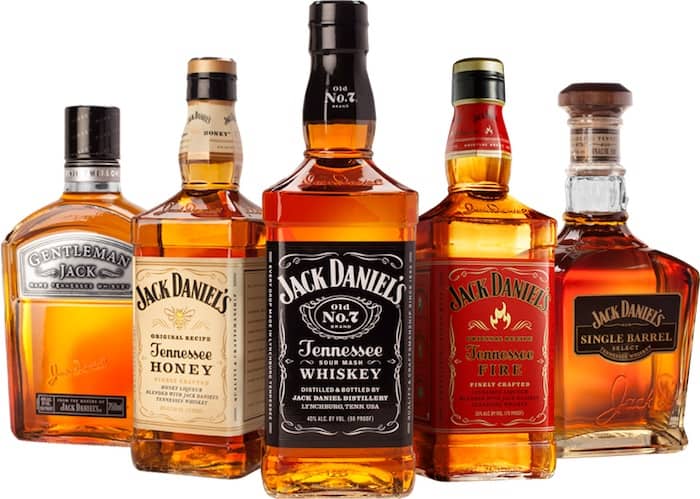It’s a controversial statement to make, but it’s easy to defend: Jack Daniel’s has created the most diverse and well-structured portfolio of whiskey on the market today.
I’ll give you a moment to type and tweet your death threats my way. It’s true, a lot of passionate whiskey lovers in Reddit threads and Facebook groups get easy back slaps for universally panning the good work of Jack Daniel’s Tennessee whiskey. The criticisms leveled at the brand are often founded in creativity or volume; either Jack Daniel’s is too big to be authentic, or its offerings are too boring–where’s the 35-year-old Tennessee whiskey finished in barrels made from the last tree from “The Lorax?”
Here’s the thing about Jack Daniel’s: it may not be your everyday whiskey, and it may not be your favorite in your collection, but they’ve created a portfolio of diverse offerings, and more importantly, those offerings are designed and positioned to make sure there’s really something for everyone.

Jeff Arnett has been Master Distiller at Jack Daniel’s for more than decade. He knows that many of the most passionate whiskey lovers out there started with one of their products. But Jack Daniel’s has thought beyond that first sip: they’ve designed a range of bottles in response to any criticism that could be leveled at their flagship No. 7.
“A lot of people have heard of Jack Daniel’s so early in their drinking life,” Arnett explains, “if there is a good chance they are willing to try whiskey, maybe Old No. 7 will be what they try. Some people are going to start there, stay there, and love it. And that’s great.”
It’s a sentiment we hear from a lot of distillers of popular whiskey: The “we think you’ll like it, and a lot of people do” approach to doing your best with your best product. But Arnett’s wisest point is what comes after that: Not everyone will fall in love. So what then?
That realization began a series of portfolio additions that have taken years, but have eventually led Tennessee whiskey in new directions tailored to simple, customer-centric adjustments to an established product.
Take Gentleman Jack, for instance. Gentleman Jack is on the market for one reason, according to Arnett. “People will taste it and say ‘well if I was being honest to my preferences it would be more this or less that.’ Gentleman Jack,” he says, “was largely built in response to people who had tried Black Label and said ‘I don’t really drink a lot of Jack Daniel’s and if I were to be honest I don’t like the aftertaste of oak. When I swallow it, it can be a little harsh.’ Unfortunately it’s part of bringing a brand new barrel into a warm climate. We can’t avoid creating that character in the whiskey; it’s just going to happen.”
With Gentleman Jack they found a way to preserve the personality of Jack Daniel’s while taking a little bit of the oak’s bitter character out after years of aging: reintroducing the aged whiskey to new charcoal. “Working with charcoal as we have, we know that charcoal tends to be selective. It removes taste in the bitter zone, and so taking Black Label through it, you can keep the sweetness of the barrel and largely remove the aftertaste.”
Gentleman Jack brings up a specific question, which we felt the need to ask Arnett: Does Tennessee Whiskey and its use of charcoal give it an advantage over, say, bourbon, when trying to structure the perfect portfolio?
I won’t say he dodged the question, but he took credit where credit is due: knowing how to use the tool. Or should we say tools? Arnett sees the charcoal like an ingredient, or a spice: introduce a little bit here, and you’ll get a different result than releasing it later on. Use more, and you’ll have a different effect than from using less. “I think it’s all in how you leverage the charcoal,” he explains. “When we created Gentleman Jack, the second pass on it was not like the first. I can tell you for sure that if you know what your doing with it, you can take two whiskey’s that are similar and make them different.”
Of course the sword swings both ways: If you’re going to give people an easier drinking whiskey, you should give them a bold one too, and that’s how Single Barrel came to be. Arnett says that the Single Barrel range is “for those who are looking for that next level of character. Single Barrel definitely provides a step up in barrel character, because everyone is different.”
One thing you’ll notice is that, regardless of what the product it, everything beyond No. 7 has started with a segment of the whiskey drinking population that wasn’t being served by the original product. “It’s about recognizing that not everybody would describe the perfect whiskey or the ideal whiskey the same way,” Arnett says. “They have different wants and desires. They have different pictures of what they want it to look like, taste like, and how they would consume it–and what the appropriate occasions for it,” he explains. “So that’s how we have gone from three to ten. We have either seen potential in a new consumer, new market or a new occasion that we fulfill.”
(story continues on page 2 below)








